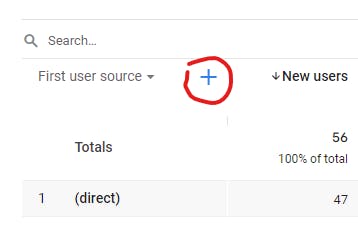Optimize Your Reporting with Secondary Dimension in Google Analytics
Optimize Your Reporting with Secondary Dimension in Google Analytics
Blog Article
Transform Your Analytics Approach With Secondary Dimension in Google Analytics
By incorporating second measurements into information analysis, a brand-new layer of insights emerges, dropping light on elaborate user habits and communications. The calculated application of second measurements holds the key to opening a treasure trove of very useful details that can transform exactly how businesses act and analyze upon their information.
Recognizing Additional Dimensions in Google Analytics
Second measurements in Google Analytics give extra context to key information by allowing customers to analyze metrics throughout a second dimension, providing deeper understandings right into customer actions and interactions on an internet site. Secondary Dimension in Google Analytics. While key dimensions offer essential data factors such as pageviews, bounce rate, and session duration, secondary measurements provide an even more comprehensive sight by segmenting the main information additionally. This segmentation permits individuals to analyze metrics in combination with one more dimension, such as website traffic resources, demographics, or customer habits
Advantages of Making Use Of Additional Measurements
Utilizing additional measurements in Google Analytics offers a calculated advantage by improving the deepness of evaluation and providing a more extensive understanding of user communications and behavior on an internet site. By incorporating additional dimensions, experts can gain important understandings right into the performance of details sectors or variables within their data. This enables an extra detailed exam of user behavior beyond surface-level metrics, permitting a deeper expedition of the elements affecting individual involvement and conversions.

Just How to Apply Additional Measurements
When integrating secondary dimensions in Google Analytics, one necessary step is to select the relevant metrics and measurements to improve the analysis procedure. Clicking on this button will open a drop-down food selection listing different dimensions that can be added to your key measurement for much deeper understandings.
After choosing the appropriate additional measurement, such as 'Source/Medium' or 'Device Category,' Google Analytics will certainly show the data in an extra comprehensive format, permitting you to cross-analyze different facets of individual habits. Remember to try out different mixes of additional and primary dimensions to discover beneficial patterns and trends that can inform your marketing approaches. By executing second dimensions attentively, you can gain a more comprehensive understanding of your website or app performance and make data-driven decisions to maximize your electronic existence.
Studying Data With Second Measurements
Boost your data analysis in Google Analytics by integrating additional dimensions to delve deeper into individual habits patterns and maximize your electronic marketing techniques successfully - Secondary Dimension in Google Analytics. By adding second measurements to your main information, you can get useful understandings that can aid you go to this web-site make educated choices regarding your internet site or app efficiency
Evaluating data with secondary measurements permits you to section your main data additionally, supplying a much more extensive view of customer communications. For example, integrating the key dimension of 'source/medium' with a secondary measurement like 'touchdown page' can reveal which certain pages are driving web traffic from various sources. This information can be crucial in refining blog your web content strategy or maximizing your advertising and marketing projects to enhance conversions.
Furthermore, using additional dimensions enables you to determine relationships in between different metrics, aiding you comprehend the impact of different variables on customer actions. Whether it's analyzing demographics alongside user interaction metrics or device classifications with conversion prices, secondary measurements equip you to discover hidden trends and patterns that can lead your advertising initiatives.
Maximizing Efficiency With Second Measurements
To improve the performance of data analysis and decision-making in Google Analytics, incorporating additional measurements is crucial to enhancing efficiency metrics and obtaining deeper insights right into individual actions patterns. By utilizing secondary measurements, analysts can delve beyond surface-level information and reveal valuable correlations that may otherwise go undetected. This optimization strategy enables businesses to tailor their advertising efforts better, recognize locations for renovation in internet site functionality, and enhance total user experience.
Additional dimensions use a my website more comprehensive view of user interactions by offering added context to main data metrics. Combining the main measurement of 'landing web page' with a second dimension like 'tool category' can disclose whether certain gadgets are more likely to drive interaction on certain touchdown pages. This understanding can notify receptive style enhancements or targeted marketing methods to boost efficiency.

Conclusion
To conclude, the assimilation of second dimensions in Google Analytics offers companies with an effective tool to enhance their analytics approach. Secondary Dimension in Google Analytics. By diving deeper into user actions and interactions, marketing professionals can uncover beneficial understandings that can drive efficiency optimization and improve the total individual experience. Leveraging additional dimensions permits a much more extensive evaluation of information, resulting in even more enlightened decision-making and customized marketing initiatives
Second dimensions in Google Analytics give added context to primary data by enabling users to assess metrics throughout a second measurement, providing much deeper understandings into customer behavior and communications on a website. While main dimensions offer fundamental data factors such as pageviews, bounce rate, and session period, secondary dimensions provide an even more comprehensive view by segmenting the key data additionally.One of the key benefits of utilizing second dimensions is the capability to reveal correlations and patterns that might not be right away apparent when examining data with main measurements alone.When incorporating additional measurements in Google Analytics, one vital action is to pick the relevant metrics and measurements to improve the analysis process. Pairing the main measurement of 'landing page' with an additional measurement like 'tool category' can expose whether particular tools are much more most likely to drive engagement on details landing web pages.
Report this page